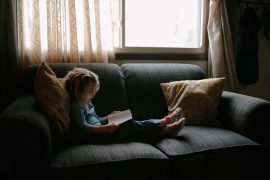Redirection is the best way to stop the behaviour because it channels the energy. ”I see that’s so much fun! And you know the couch is not for jumping. Come, off the couch. Let’s go jump on the old mattress in the basement.”
All kids will naturally test limits to see if they’re firm. That means that for now, you’ll need to stay with her as you enter the house and help her get those shoes off, every time, before she heads for the couch. Eventually, it will become a habit, and neither of you will even think about it.
But what if she darts away from you and makes a beeline for the couch, before you can get her shoes off? She’s sending you a signal that something’s getting in the way of her cooperating with you. What? Emotions. Kids store up their feelings, waiting for a safe chance to release them with a compassionate witness. That’s you. If you get to the bottom of these tangled emotions, you’ll stop “bad” behaviour before it starts.
Sure, you can make her “stuff” those feelings, by screaming at her or punishing her. She’ll comply, eventually – until she’s old enough to rebel. The teen years won’t be pretty. And you’ll never be as close as you could be to this person you brought into the world.
Or you can help her with those feelings. That will help her cooperate with your agenda. It will teach her emotional intelligence. It will make her more able to meet your expectations as she gets older. And it will bring you closer. How? Play when you can. Cry when you have to.
7. Help the child with the feelings that are keeping him from cooperating – Play when you can
Take a deep breath and repeat after me: “It is not an emergency. We can play with this.”
Keep your tone light and playful, so you get her giggling. “Excuse me?! Are you on that couch with your shoes on?! We’ll see about that! I’m the couch protector, and I always get my girl!”. Scoop her up, laughing, and toss her over your shoulder. As you run around the house with her, take her shoes off and toss them towards where they belong. Sing a silly chant about how much you love her and you’ll never let her go. Keep dropping her on the couch and scooping her up again. Finally, collapse together on the couch for a good snuggle.
The next time you enter the house, before you go in the door, tell her you want to play the game again, but first she has to take her shoes off with you, right inside the door.
Transform the game from one of defiance into one of re-connection and celebration. Use it any time you need to, to interrupt “bad” behaviour.
Giggling releases upset feelings almost as well as crying does. It also creates more oxytocin, the bonding hormone, so when you and your child are laughing together, you’re bonding.
8. Help the child with the feelings that are keeping him from cooperating – Cry when you have to
What if she doesn’t giggle? Won’t let you take her shoes off? Gets angry and defiant? She’s beyond play. Her provocative behaviour is letting you know that she just needs to cry and express all those emotions she’s been stuffing. Wouldn’t it be a lot better if she could just say ”Mom, I feel like someone is always telling me what to do…I get so tired of it!”.
But she can’t TELL you how she feels so instead she SHOWS you, with her defiance.
Summon up all your compassion. Look her in the eye. Set your limit clearly and kindly. “Sweetie, you know shoes get the couch dirty. I won’t let you wear shoes on the couch.”
If you’re able to stay compassionate, she may burst into tears. (If you take this personally and get mad, there’s no way you’ll get to tears – you’ll just have a fight on your hands.). Hold her while she cries, if she’ll let you. Don’t talk much, just tell her she’s safe. If she lashes out, remember that the tears are right behind the anger. She just needs to feel a little safer to let them out.
You build safety in the moment with your calm compassion. You build safety throughout all your interactions with your child with connection and empathy, as well as with play, and with physical connection. Which brings us to:
9. Hugs
I agree that hugs are not our only tactic to reconnect and create cooperation. But they are probably our most useful. Hugs heal the disconnection that drives so much of the child’s misbehaviour, so hugs help children WANT to cooperate.
Hugs melt away the crankiness and anger and help the child feel safe enough to cry and let out the upsets that are driving her to act out. And they remind us that our child, even if he’s acting “bratty,” is our beloved.
Hugs rescue our child from the low road he’s stumbled onto and pull him back up onto the high road with us. Hugs are no substitute for 24/7 empathy and daily one-on-one reconnection time with your child, but nine hugs a day are essential for him to thrive and want to cooperate.
So for today, why not try more hugs?
“Disconnection is at the heart of many behaviour problems. We often respond to “bad behaviour” with isolation, time outs, humiliation, hitting, slapping, threats, yelling or withdrawal of love. These responses create even more disconnection, which is why they don’t work very well.” – Dr. Lawrence Cohen
Find the original article here.
Dr. Laura Markham is the founder of AhaParenting.com and author of Peaceful Parent, Happy Kids, Peaceful Parent, Happy Siblings and her latest book, the Peaceful Parent, Happy Kids Workbook.










